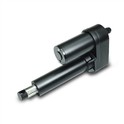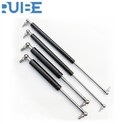As a supplier of gas struts for tool boxes, I often receive inquiries from customers about the maximum angle of opening for a tool box equipped with gas struts. This is a crucial question as it directly impacts the usability and functionality of the tool box. In this blog post, I will delve into the factors that determine the maximum opening angle and provide some insights based on our experience in the industry.


Understanding Gas Struts
Before we discuss the maximum opening angle, let's briefly understand what gas struts are and how they work. Gas struts, also known as gas springs, are mechanical components that use compressed gas to provide a controlled force. They consist of a cylinder filled with nitrogen gas and a piston rod that moves inside the cylinder. When the piston rod is pushed or pulled, the gas inside the cylinder is compressed or expanded, creating a force that either extends or retracts the piston rod.
In the context of tool boxes, gas struts are used to assist in opening and closing the lid. They provide a smooth and controlled motion, making it easier to access the tools inside the box. The force exerted by the gas strut is determined by the pressure of the gas inside the cylinder and the cross-sectional area of the piston rod.
Factors Affecting the Maximum Opening Angle
Several factors influence the maximum opening angle of a tool box with gas struts. These include:
1. Design of the Tool Box
The design of the tool box plays a significant role in determining the maximum opening angle. The shape and structure of the box, as well as the location of the hinges and mounting points for the gas struts, can all affect how far the lid can open. For example, a tool box with a shallow design may have a larger maximum opening angle compared to a deeper box, as there is less interference between the lid and the contents of the box.
2. Type and Size of Gas Struts
The type and size of gas struts used in the tool box also impact the maximum opening angle. Different gas struts have different force ratings and stroke lengths, which determine how much force they can exert and how far they can extend. Choosing the right gas struts for your tool box is essential to ensure that they can support the weight of the lid and provide the desired opening angle.
3. Mounting Position of Gas Struts
The mounting position of the gas struts is another critical factor. The angle at which the gas struts are mounted on the tool box can affect the direction and magnitude of the force they exert. Proper mounting ensures that the gas struts can effectively assist in opening and closing the lid and that the maximum opening angle is achieved.
4. Friction and Resistance
Friction and resistance within the tool box, such as between the lid and the box body or at the hinges, can also limit the maximum opening angle. Over time, dirt, debris, and wear and tear can increase friction, making it more difficult for the lid to open fully. Regular maintenance, such as cleaning and lubricating the hinges and gas struts, can help reduce friction and ensure smooth operation.
Typical Maximum Opening Angles
In general, the maximum opening angle of a tool box with gas struts can range from 90 degrees to 180 degrees. However, most tool boxes typically have a maximum opening angle of around 110 to 130 degrees. This range provides a good balance between accessibility and stability, allowing users to easily reach the tools inside the box while ensuring that the lid remains secure when open.
Applications and Considerations
The maximum opening angle of a tool box can have implications for its various applications. For example, in industrial settings where quick access to tools is essential, a larger opening angle may be preferred. On the other hand, in situations where space is limited, a smaller opening angle may be more practical.
When selecting gas struts for a tool box, it is important to consider the specific requirements of the application. Factors such as the weight of the lid, the frequency of use, and the environment in which the tool box will be used should all be taken into account.
Our Gas Struts for Tool Boxes
As a supplier of Gas Spring for Tool Box, we offer a wide range of high-quality gas struts suitable for different types and sizes of tool boxes. Our gas struts are designed to provide reliable and consistent performance, ensuring smooth opening and closing of the tool box lid.
We also provide Gas Spring for Car and Gas Spring for Furniture, catering to various industries and applications. Our team of experts can assist you in selecting the right gas struts for your specific needs, taking into account factors such as the maximum opening angle, force requirements, and mounting options.
Contact Us for Purchase and Consultation
If you are looking for gas struts for your tool box or have any questions about the maximum opening angle or other related topics, we encourage you to contact us. Our experienced sales team is ready to provide you with detailed information and guidance to help you make the best choice for your project. Whether you are a small business owner, a DIY enthusiast, or an industrial user, we can offer the right solutions for your gas strut needs.
References
- "Gas Spring Technology Handbook" by Suspa Inc.
- "Engineering Mechanics: Statics and Dynamics" by Russell C. Hibbeler






